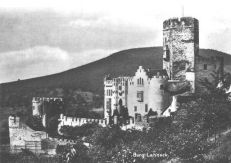Origin of the Schilling Family
The origin of the family is lost in the shadow of the mystic past.
Erik Sjölding
Since the legendary chronicle of Bernhard Schilling von Lindeck-Forst, which, according to Heinar Schilling, he wrote as the Zurich Augustinian monk named Bonifazius in about 1320, some Schillings like to think that they are members of the Erik lineage.
Bonifazius says that Erik Skjölding (named in 894) had a disagreement with his father, King Harald of Norway, and came to Rheinfelden near Lake Constance after "long wandering travels". There he was given a property in fee simple by Duke Burcart.
Erik's descendants are alleged to have stayed in Rheinfelden as counts, dukes and even once as a king (Rudolf II, a rival king), with possessions in Lindek, Lindek-Forst and Sparnek.
An offspring of the family is said to have gone to Lahneck as a chatelain of the Electorate of Mainz.
Heinrich III Schilling von Lahnstein and Descendents
Heinrich III Schilling von Lahnstein, called Huneswin (died in 1221), is assumed to have been the progenitor of the family. There developed:
- The Western, bourgeois Schilling line

- The Eastern line of the Barons Schilling
- The Southern line of the Freiherrs Schilling v. Canstatt
This common ancestor Heinrich Schilling lived at Lahneck Fortress from 1166 to 1221.
He had three sons, of whom Johannes continued the Western line. His brother Heinrich was probably the progenitor of the Southern line, that of the Schillings v. Canstatt. Johannes' son, Heinrich, carried on the Western line, while his brother Friedrich became the progenitor of the Eastern line.
Conspiracy
And now things get a bit bloodthirsty – times were wild in Germany then. King Rudolf von Habsburg, who died in 1291, wanted his son Albrecht to be his successor. But, for political reasons, the Electors chose Count Adolf von Nassau, who had no power. The Habsburg were resentful, and in 1292 a battle was fought near Göllheim in the Central Rhine region, at which Adolf put up a good showing but was killed.
Our valiant forebears, some of whom were chatelains for the Nassau family, did not accept the situation calmly and swore blood vengeance. But since the Electors had meanwhile moved over to the Habsburg camp, the Schillings were suddenly left standing almost alone. Nevertheless, they joined a conspiracy headed by Albrecht's nephew Johann (also known as Parricida), who killed the king on 1st May 1308 near Brugg an der Reuss. A son of Heinrich Schilling, called Bernhard, was also involved and died in this bloodbath fought at the foot of the Habsburgs' ancestral fortress. His brother Friedrich, the progenitor of the Eastern Schillings, was party to the conspiracy too. He is said to have been executed in Cologne in 1310.
Bernhard's son Friedrich (Western line) was placed under an Imperial Ban. He fled across the Alps to Bohemia, settled in Prague and finally became a City Councillor in Breslau. Here it becomes clear that the Schillings have always been of a rebellious nature. Friedrich's son Daniel was a follower of John Huss, the church reformer and had to flee to Hof, where his offspring initially stayed. Another descendant, Hanss Schilling (1470 - 1539), moved to Thuringia and with him the Schillings began to flourish in this part of Germany. His son Matthes (1510 - 1541) was a mining court official in Eisleben. His son founded the House of Proschwitz. One of his descendants was the famous sculptor Johannes Schilling (1828 - 1910) in Dresden.
Martin, another of Matthes' sons, is the progenitor of the Martinides. He was initially a clergyman in Mulden in Bohemia. This Schilling too was a rebel. So in the course of the Counter-Reformation, he had to flee to Thuringia and finally settled in Pegau in the Erzgebirge. His son Martin (1578 - 1620) initially owned a mine in Zella and then went to Suhl, where he worked as a blacksmith. His son Kasper set up the first blast furnace in Suhl.